
A paratrooper is a military parachutist—someone trained to parachute into an operation, and usually functioning as part of an airborne force. Military parachutists (troops) and parachutes were first used on a large scale during World War II for troop distribution and transportation. Paratroopers are often used in surprise attacks, to seize strategic objectives such as airfields or bridges.

The Indo-Pakistani War of 1965 was a culmination of skirmishes that took place between April 1965 and September 1965 between Pakistan and India. The conflict began following Pakistan's Operation Gibraltar, which was designed to infiltrate forces into Jammu and Kashmir to precipitate an insurgency against Indian rule. India retaliated by launching a full-scale military attack on West Pakistan. The seventeen-day war caused thousands of casualties on both sides and witnessed the largest engagement of armored vehicles and the largest tank battle since World War II. Hostilities between the two countries ended after a ceasefire was declared through UNSC Resolution 211 following a diplomatic intervention by the Soviet Union and the United States, and the subsequent issuance of the Tashkent Declaration. Much of the war was fought by the countries' land forces in Kashmir and along the border between India and Pakistan. This war saw the largest amassing of troops in Kashmir since the Partition of India in 1947, a number that was overshadowed only during the 2001–2002 military standoff between India and Pakistan. Most of the battles were fought by opposing infantry and armoured units, with substantial backing from air forces, and naval operations.

The Assam Rifles is the oldest paramilitary force of India, dating back to 1835 under the British Raj, raised under the name Cachar Levy. The present name of "Assam Rifles" has been used since 1917. Over the course of its history, the Assam Rifles have served in a number of roles, conflicts and theatres including World War I, where they served in Europe and the Middle East, and World War II, where they served mainly in Burma. After the Chinese annexation of Tibet, the Assam Rifles were tasked with manning the Tibet border of Assam Himalayan region. They were also instrumental in maintaining law and order in the tribal Arunachal Pradesh.

The Pakistan Army is the land service branch of the Pakistan Armed Forces. The roots of its modern existence trace back to the British Indian Army that ceased to exist following the partition of the Indian subcontinent, resulting in the parliamentary act that established the sovereign state of Pakistan from the United Kingdom on 14 August 1947. According to statistics provided by the International Institute for Strategic Studies (IISS) in 2020, the Pakistan Army has approximately 560,000 active-duty personnel, supported by the Army Reserve and National Guard—effectively making it the 15th army in the world in terms of manpower. Pakistani citizens can enlist for voluntary military service upon reaching 16 years of age, but cannot be deployed for combat until age 18 in accordance with the constitution of Pakistan.
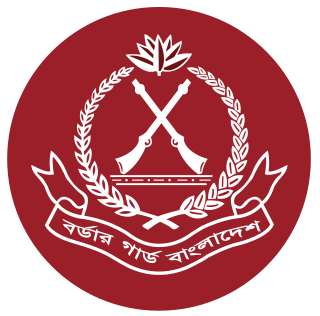
The Border Guard Bangladesh (BGB) is a paramilitary force responsible for the border security of Bangladesh. The force is known as "The Vigilant Sentinels of the National Frontier". Border Guard Bangladesh, as a paramilitary force, is entrusted with the responsibility to defend the 4,427 kilometres (2,751 mi) border of Bangladesh.
The Indian Home Guard is a volunteer tasked as an auxiliary to the Indian police. The Home Guards Organisation was reorganised in India in 1966 after the Sino-Indian War with the People's Republic of China, though it existed in smaller units individually in some places. Home Guards are recruited from various cross sections of the civil society such as professionals, college students, agricultural and industrial workers etc who give their spare time for betterment of the community. All citizens of India, in the age group of 18–50, are eligible. Normal tenure of membership in Home Guards is three to five years.
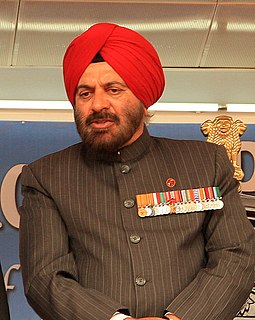
General Joginder Jaswant Singh, PVSM, AVSM, VSM, ADC was the 21st Chief of the Army Staff (COAS) of the Indian Army. He was appointed on 27 November 2004, and took over the role when his predecessor, General N C Vij, retired on 31 January 2005. He was succeeded by General Deepak Kapoor. He served as the COAS from 31 January 2005, to 30 September 2007.

General Sunith Francis Rodrigues, PVSM, VSM is a retired Indian army officer who was Chief of the Army Staff of the Indian Army from 1990 to 1993 and Governor of Punjab from 2004 to 2010.
The National Security Council (NSC) of India is an executive government agency tasked with advising the Prime Minister's Office on matters of national security and strategic interest. It was established by the former prime minister of India Atal Bihari Vajpayee on 19 November 1998, with Brajesh Mishra as the first National Security Advisor. Prior to the formation of the NSC, these activities were overseen by the Principal Secretary to the preceding Prime Minister.
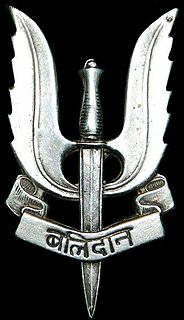
Para , also known as Para SF, are the special forces unit of the Indian Army. It is attached to the Parachute Regiment. The unit specializes in various roles including hostage rescue, counter-terrorism, unconventional warfare, special reconnaissance, foreign internal defence, counter-proliferation, counter-insurgency, seek and destroy and personnel recovery.
Jane's International Defence Review (IDR) is a monthly magazine reporting on military news and technology.

The Indian Armed Forces are the military forces of the Republic of India. It consists of three professional uniformed services: the Indian Army, Indian Navy, and Indian Air Force. Additionally, the Indian Armed Forces are supported by the Indian Coast Guard and paramilitary organisations and various inter-service commands and institutions such as the Strategic Forces Command, the Andaman and Nicobar Command and the Integrated Defence Staff. The President of India is the Supreme Commander of the Indian Armed Forces. The Indian Armed Forces are under the management of the Ministry of Defence (MoD) of the Government of India. With strength of over 1.4 million active personnel, it is the world's second-largest military force and has the world's largest volunteer army. It also has the third-largest defence budget in the world. As per 2015 Credit Suisse report, the Indian Armed Forces is the world's fifth-most powerful military, whereas the 2020 GlobalFirepower report lists it as the fourth most-powerful military.
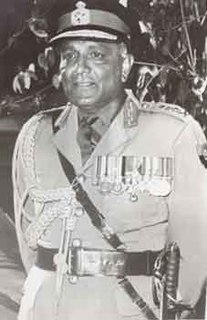
General Paramasiva Prabhakar Kumaramangalam, was the 6th Chief of the Army Staff (COAS) of the Indian Army from 1967 to 1969. He was among the last of the King's Commissioned Indian Officers trained in England in the Indian Army, and the last King's Commissioned Indian Officer (KCIO) to lead the Indian Army.
Major General Afsir Karim, was a retired Indian Army general and military scholar who has authored several books on strategic affairs & military studies. He is a graduate of the Defense Services Staff College, Wellington and the National Defence College.
Lieutenant General Ranjit Singh Dyal, PVSM, MVC was an Indian Army general and an administrator. As a soldier, Ranjit Singh led the capture of the Haji Pir pass by the Indian army during the 1965 war with Pakistan. He also drew up the plans for Operation Blue Star, and served as the General-Officer-Commanding-in-Chief of the Southern Command. Later, he served as Lieutenant Governor of Puducherry and the Andaman and Nicobar Islands.

185th Paratroopers Division Folgore or 185ª Divisione Paracadutisti Folgore was a Parachute Division of the Italian Army during World War II.

The 50th Parachute Brigade is a brigade-sized formation of the Indian Army. Its main force is formed of battalions of the Parachute Regiment. It consists of 2 Airborne Special Forces battalions, supported by units of the Regiment of Artillery, the Corps of Engineers and a Para-field hospital.
Indian Depository Receipt (IDR) is a financial instrument denominated in Indian Rupees in the form of a depository receipt. The IDR is a specific Indian version of the similar global depository receipts.
Ashok K. Mehta is a former major general of the Indian Army, as well as a radio and television commentator and a columnist on defence and security issues. He was a founding member of the Defence Planning Staff in the Indian Ministry of Defence. He is also the elder brother of the renowned journalist and editor, Vinod Mehta. Ashok Mehta is married to journalist Aditi Phadnis.
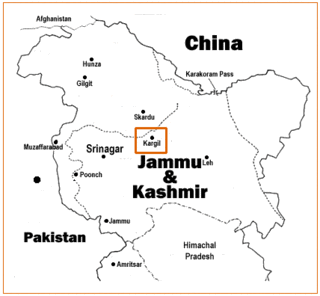
The Kargil Review Committee (KRC) was set up by the Government of India on 29 July 1999, three days after the end of the Kargil War. The committee was set up "to examine the sequence of events and make recommendations for the future".












